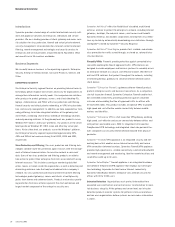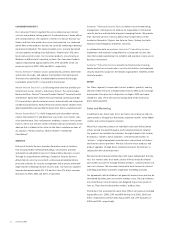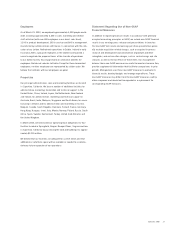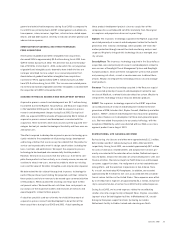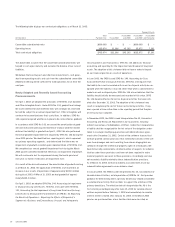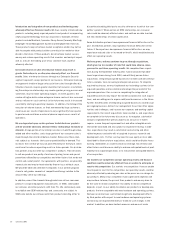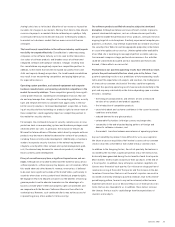Symantec 2003 Annual Report Download - page 31
Download and view the complete annual report
Please find page 31 of the 2003 Symantec annual report below. You can navigate through the pages in the report by either clicking on the pages listed below, or by using the keyword search tool below to find specific information within the annual report.
Symantec 2003 29
estimated reserves for such end-user product returns, which are
recorded as an offset to revenue, are based primarily on historical
trends. Our return policy allows distributors and resellers, subject to
certain contractual limitations, to return purchased products in
exchange for new products or for credit towards future purchases.
Product returns by distributors and resellers principally relate to stock
balancing and the replacement of obsolete products. Channel revenue
deferrals, as discussed above, are designed to take into account any
distributor and reseller stock balancing returns. In addition, we fully
reserve for obsolete products in the distribution channels. We also
consider other factors such as the timing of upgrades and new versions
of products, current market conditions, economic trends and changes
in technology. If we made different judgments or utilized different
estimates, material differences may result in the amount and timing
of our net revenues for any period presented.
Reserves for Rebates We estimate and record reserves as an offset to
revenue for channel and end-user rebates, related primarily to products
within our Enterprise Security, Enterprise Administration and Consumer
segments. Our estimated reserves for channel volume incentive rebates
are based on distributors’ and resellers’ actual performance against the
terms and conditions of volume incentive rebate programs, which are
typically entered into quarterly. Our reserves for end-user rebates are
estimated on the terms and conditions of the promotional program,
actual sales during the promotion, amount of actual redemptions
received, historical redemption trends by product and by type of promo-
tional program and the value of the rebate. We also consider current
market conditions and economic trends when estimating our reserve for
rebates. If we made different judgments or utilized different estimates,
material differences may result in the amount and timing of our net
revenues for any period presented.
Allowance for Doubtful Accounts We maintain an allowance for doubt-
ful accounts to reserve for potential uncollectible trade receivables.
We review our trade receivables by aging category to identify specific
customers with known disputes or collectibility issues. We exercise judg-
ment when determining the adequacy of these reserves as we evaluate
historical bad debt trends, general economic conditions in the U.S. and
internationally, and changes in customer financial conditions. If we
made different judgments or utilized different estimates, material differ-
ences may result in additional reserves for trade receivables, which
would be reflected by charges in general and administrative expenses
for any period presented.
Impairment of Long-Lived and Intangible Assets and Goodwill We
evaluate goodwill for impairment in accordance with Statement of
Financial Standards, or SFAS, No. 142, Goodwill and Other Intangibles,
which requires that goodwill no longer be amortized and that goodwill
be tested for impairment annually, or more frequently if events and cir-
cumstances warrant. We performed the initial goodwill impairment test
required by SFAS No. 142 during the June 2002 quarter. We identified
four reporting units, which represent our primary operating segments,
and determined that there was no impairment of goodwill recorded
upon implementation of SFAS No. 142. We completed our annual
goodwill impairment test during the March 2003 quarter and deter-
mined that there was no impairment of goodwill. We will continue to
test for impairment during the fourth quarter of each year, or earlier
if indicators of impairment exist.
We also evaluate long-lived and intangible assets, including property,
equipment, leasehold improvements and acquired product rights, for
impairment whenever events or changes in circumstances indicate that
the carrying amount of an asset may not be recoverable. An impairment
loss would be recognized when the sum of the undiscounted future net
cash flows expected to result from the use of the asset and its eventual
disposition is less than its carrying amount. Such impairment loss would
be measured as the difference between the carrying amount of the asset
and its fair value. Significant judgment is required in the forecasting of
future operating results, which are used in the preparation of projected
cash flows. If we made different judgments or utilized different estimates,
material differences may result in write-downs of net long-lived and
intangible assets, which would be reflected by charges to our operating
results for any period presented.
Restructuring and Site Closures During fiscal 2003 and 2002, we
incurred expenses related to consolidating, moving and relocating vari-
ous groups or sites. In determining the charge related to our excess
facilities, certain estimates were used, such as the ability to sublease
the facilities, the terms of future subleases, broker commissions, costs
of tenant improvements and related exit costs. In developing our esti-
mates, we obtained information from third party leasing agents to cal-
culate anticipated third party sublease income and the vacancy period
prior to finding a sub-leasee. Market conditions will affect our ability to
sublease facilities on terms consistent with our estimates. Our ability
to sublease facilities ahead of schedule or the negotiation of lease terms
resulting in higher or lower sublease income than estimated will affect
our accrual and the related charge for restructuring, site closures and
other expenses. Differences between estimates of related broker com-
missions, tenant improvements and related exit costs may increase or
decrease our accrual upon final negotiation. If we employed different
assumptions regarding these various components of our exit costs, the
costs recorded for any period presented could vary materially from
those actually recorded.
Deferred Income Taxes On a quarterly basis we evaluate our deferred
tax asset balance for realizability. To the extent we believe it is more
likely than not that some portion or all of our deferred tax assets will
not be realized, we will establish a valuation allowance against the
deferred tax assets. Realization of our deferred tax assets is dependent
upon future U.S. taxable income and future taxable income in certain
foreign jurisdictions, as well as our implementation of prudent and
feasible tax planning strategies. Our judgments regarding future prof-
itability may change due to future market conditions, changes in U.S.
or international tax laws and other factors. These changes, if any, may
require possible material adjustments to these deferred tax assets,
resulting in a reduction in net income or an increase in net loss in the
period when such determinations are made.



